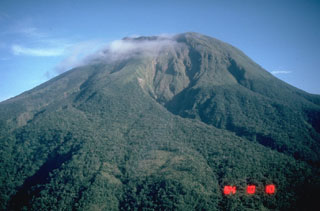Report on Bulusan (Philippines) — January 1995
Bulletin of the Global Volcanism Network, vol. 20, no. 1 (January 1995)
Managing Editor: Richard Wunderman.
Bulusan (Philippines) Phreatic ash eruptions continue with low seismicity and deformation
Please cite this report as:
Global Volcanism Program, 1995. Report on Bulusan (Philippines) (Wunderman, R., ed.). Bulletin of the Global Volcanism Network, 20:1. Smithsonian Institution. https://doi.org/10.5479/si.GVP.BGVN199501-273010
Bulusan
Philippines
12.769°N, 124.056°E; summit elev. 1535 m
All times are local (unless otherwise noted)
Phreatic activity that started in November continued through December and January (table 1). Another eruption on 21 January at 2237 generated rumbling noises, lightning flashes over the summit, and light ashfall at the San Benon Observatory, ~5 km SW. Based on the seismic record, this event was fairly strong, but ash deposits measured later that day (1-2 mm, 7 km downwind) were similar in amount to previous ash emissions. COSPEC measurements could not be undertaken because of heavy cloud cover. The interval between this ash eruption and the previous had increased, which, along with very low seismicity and ground deformation, may be taken as an indicative of decreasing activity. Alert Level 2 was maintained, which advises against anyone visiting within 4 km of the summit. This warning of heightened volcanic activity was non-committal about the timing of future events because seismicity and deformation have not changed prior to these short-lived ash eruptions.
Table 1. Summary of recent phreatic eruption at Bulusan, 27 November 1994 to 28 January 1995. Data courtesy of PHIVOLCS.
| Date | Ashfall | Comments |
| 27 Nov 1994 | In villages W and SW | 14 minutes of felt tremor; 1.5-km-high plume |
| 03 Dec 1994 | -- | Rumbling; heavy cloud cover |
| 04 Dec 1994 | Traces 7 km away | -- |
| 05 Dec 1994 | In villages 5 km WSW | 1.5-km-high plume |
| 12 Dec 1994 | As far as 16 km SW | Cauliflower-shaped column 3 km high |
| 18 Dec 1994 | In five villages SW | Small explosion; cloud cover |
| 20 Dec 1994 | ~7 km SW | Small explosion; cloud cover |
| 23 Dec 1994 | Light ashfall in six villages SW | Four minutes long |
| 24 Dec 1994 | Light ashfall ~7 km away | Three minutes long |
| 27 Dec 1994 | Nine villages | Seven minutes; largest since 12 Dec |
| 31 Dec 1994 | Ash ejection | Rumbling & lightning flashes |
| 07 Jan 1995 | Light ashfall 5-6 km away | -- |
| 10 Jan 1995 | Very light ashfall 7 km SW | Plume 1 km above summit |
| 21 Jan 1995 | Light ashfall 5 km SW | Lightning flashes over summit |
| 28 Jan 1995 | Max 3 mm of ash up to 15 km away | Plume 2 km high |
Another explosion on 28 January at 1433 produced a 2-km-high ash cloud above the summit craters and deposited andesitic ash (<=3 mm) on villages up to 15 km downwind. This event, recorded by the local seismic network as an explosion-type earthquake, was again preceded by low and unremarkable local seismicity; most earthquakes and short-duration tremor have occurred after each explosion. Ground deformation was also at background levels. Because no escalating activity has been detected, as of 1 February there was no change in 4-km-radius danger zone and no evacuation was recommended. No damage to crops or villages have been reported nor have there been any injuries as a result of these eruptions.
Geological Summary. Luzon's southernmost volcano, Bulusan, was constructed along the rim of the 11-km-diameter dacitic-to-rhyolitic Irosin caldera, which was formed about 36,000 years ago. It lies at the SE end of the Bicol volcanic arc occupying the peninsula of the same name that forms the elongated SE tip of Luzon. A broad, flat moat is located below the topographically prominent SW rim of Irosin caldera; the NE rim is buried by the andesitic complex. Bulusan is flanked by several other large intracaldera lava domes and cones, including the prominent Mount Jormajan lava dome on the SW flank and Sharp Peak to the NE. The summit is unvegetated and contains a 300-m-wide, 50-m-deep crater. Three small craters are located on the SE flank. Many moderate explosive eruptions have been recorded since the mid-19th century.
Information Contacts: R. Punongbayan and E. Corpuz, PHIVOLCS.

